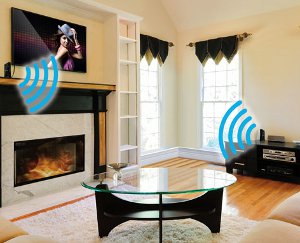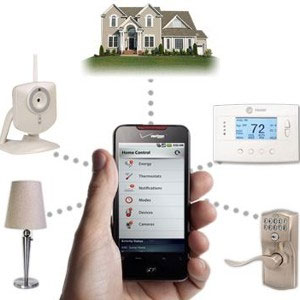
6 Most Important Pieces of Info to Share with Your Tech Installer
 Tidbits about your lifestyle, family and home can net a well-designed A/V and automation system. Tidbits about your lifestyle, family and home can net a well-designed A/V and automation system.
A realtor wouldn’t dream of selling you a house without understanding your needs and wants (or “must-haves” as they’re known these days). The same goes for the professional who designs and installs A/V and automation systems into homes. In order to provide a customer with technology that will truly enhance the convenience, comfort and entertainment value of a home, he needs to learn about how those homeowners live in their home now, what they’d like to improve about the house and how they envision life in an automated residence, among other tidbits. (To see home tech requests achieved to their fullest, check out our Home of the Year Award winners.)
“It’s like peeling back an onion,” says custom electronics (CE) professional Tommy Kissell of Texas-based Eco High Fidelity, of his first meetings with prospective clients. “The more we know about a client, the better equipped we’ll be to design a system that suits their habits, routines, schedules and lifestyle.” So what are some of the areas you can expect your CE pro to ask you about?
The House Itself
Certainly, he’ll need to know whether you plan to automate an existing house, will be remodeling or would like to put the system into a house that’s on the drawing boards. Some of your first meetings with a CE pro could take place at your house; this will give the installer an opportunity to gauge the complexity of the job. He’ll need to see if there’s an attic, basement or crawlspace through which to fish cabling; if not, he may investigate other wiring avenues. He’ll be able to see first-hand if there are any materials like concrete and stucco that could make the project more difficult. Also, he’ll probably ask you about current technologies your home might already have: built-in speakers, a computer network, a security system? With a clear understanding of your home’s makeup, a CE pro will be able to determine the types of tools and manpower he will need to get the job done, and what types of products and systems—for example, wireless or hardwired—will work best.
Inconvenient Truths
Everybody can rattle off a few items they find annoying or inconvenient about their home. Maybe it’s the closet and bathroom lights that nobody bothers to turn off, or the tedium of locking up and shutting things off before bedtime. A CE pro wants to hear your pet peeves you so he can design your system that takes care of those trouble spots. Don’t hold back, and make sure every member of the family has a say.
Comfort with Technology
How do you use technology in your home now? For example, are you a fan of streaming music and video services? Are you a PC or Mac user? Do your kids do much of their homework online? What about mobile devices? Are they loaded with apps? A CE pro can tell a lot by your current use of and familiarity with technology. For example, if everyone in family is an avid user of an iPad, your CE pro may design a system that lets you use this device to manage and monitor your home systems. If you have thousands of CDs, then those might be prioritized within a whole-house audio system over streaming services, for example (or perhaps you’d rather pare down the collection and simplify to the streaming route).
Way of Life
Lifestyle is a big buzzword in the home technology industry, and for good reason. A candid discussion of your way of life will likely reveal the most important pieces of information a CE pro needs to design and implement a system so in sync with you and your family that you’ll wonder how you ever managed without it. At the very least, expect to divulge your household status (single, married, kids, elderly parents), your family’s schedule (work, school, travel), your social life (do you entertain frequently) and your hobbies (sports, exercise, photography, art collecting, etc.). If your daily routine involves a half hour on the treadmill, perhaps you’d like to have some music piped in over in-ceiling speakers rather than be tethered to an iPod; or maybe create the proper lighting environment for displaying artwork.
Aesthetic Preferences
Do you want to show off your home electronics investment or keep it under wraps? Your aesthetic preferences will help a CE pro decide whether he should install speakers that recess into the walls or models that stand out in the open, for example. If you like the idea of having all of the A/V components (amplifiers, processors, Blu-ray players, etc.) hidden completely from view, by all means tell your CE pro. There are lots of clever ways to hide technology.
On the Clock
Prepare to have an idea of when you’d like the project started and finished. Do you want everything installed by the holidays? Is there a special event by which you’d like the project buttoned up? Based on answers to earlier questions, a CE pro is probably visualizing a system, but when you say you want it done in six weeks, he may have to rethink the plan, or may even bow out if you’re firm on the deadline. Be clear with your timeframe; be flexible if you can.
by Lisa Montgomery
http://www.electronichouse.com/article/6_most_important_pieces_of_info_to_share_with_your_installer/Learning_Center
Custom Installation Services, LLC – Call us for your free “Tech” evaluation! in Charlotte, NC and surrounding areas
Posted in 3D TV, APC, Apple, AppleTV, Audio Systems, Automation, Blu-ray, Bose Dealer, Central Vac System, HDMI Specs, Home Theater, Home Theater Design, Home Theater Setup, IP Cameras, iPad, iPhone, lifestyle, lighting control, Linksys, Low Voltage Contractors, Luxul, Media Rooms, Multi Room A/V, Netgear Routers, Network Setup, Outdoor Speakers, recycling, soundtouch, Structured Wiring, technology, Theater Seating, wave radio, Wireless Network
|
Wireless: Is It Really as Good as It Sounds?
Integrators need to educate customers better that ‘wireless’ audio does not mean ‘no new wires,’ and installing a cable-less system is not necessarily less labor intensive.
 Wireless has its place when used properly, but it doesn’t mean no new wires. It is obvious many custom manufacturers of multiroom audio systems are pinning their hopes for 2014 on new wireless audio products. Wireless is a wonderful solution; it eliminates the need to pre-wire a house and can be installed as a retrofit. Now that video can be transmitted around the home via wireless, audio transmission should be a breeze.
However, not wanting to be a wet rag, I would suggest caution. If anything sounds too good to be true, you can bet there is more to the story. When it comes to distributing audio around the home without cables, we should have a look at the practical implications more carefully.
Wireless is Not 100% Reliable
Wireless, of course is not new. My first foray into it was in the late 1960s with a wireless remote volume control. It was a fantastic idea—a little box was placed between the pre and power amplifiers so the level could be adjusted from your armchair. It worked well most of the time, but not all the time. On occasion it was slow to respond, which was quite irritating. But the real problem was when you pushed the “up” button, on occasions, it did not stop and then it would continue to increase the level unaided to full output, often destroying very expensive speakers.
Through the years wireless has greatly improved, but in a world hungry for convenience, for every improvement in wireless technology there has be a consequential demand to make it deliver more. For that reason it has never been perfect. Maybe 99 percent right at times but never 100 percent.
You may ask why is 99 percent not a good result? Those experienced in remote systems are well aware how unforgiving consumers are if they are not directly in front of a component. Now with IP-based solutions, we have upped the ante transmitting audio wirelessly as well as system control through the home. As good as we are getting with latency, the slightest drop out of signal can be very frustrating to most consumers.
‘Wireless’ Does Not Mean ‘No Wires’
As convenient as it is, a smart installer knows wireless can be fickle and when problems arise it can expose them to a lot of hassle and call backs, so hardwiring will always be their preference. To consumers, wireless solutions mean “no need to wire at all” to save costs and absolve them from need to employ an integrator or electrician or do any forward planning. The consumer needs to be better informed.
Wireless moves the amplifier from the central equipment cabinet into each individual room, which was one of the important parameters when we developed A-BUS. (Editor’s Note: A-BUS technology has the power supply located at the hub end where there is access to power. It is then sent down the Cat 5 cable to the amplifier located in the room with the speakers. Without the power supply, it is small enough to fit behind a single-gang wall plate or on the back of a speaker.)
Being from an audiophile background, long runs of speaker cable around the home have always been an anathema to me. If it is accepted, you should use good quality speaker cable to prevent signal losses to your speakers when they are just across the room from the amplifier. Running poor quality speaker cable (as our industry does) to the other end of a house must be wrong. So why do we do it?
Let’s look at why. Where do you put an amplifier in a bathroom? Even in a bedroom where you normally have a closet space available, generally homeowners don’t like electrical components hidden away in them. Putting them in ceilings sitting next to the speakers amongst the insulation material can be messy. Centrally located amplifiers in an equipment closet and nasty long speaker cable runs have been the norm.
If finding an amplifier location is hard, finding a convenient power point for it is even harder. The situation is no different to the plethora of wireless speakers coming on the market implying “no wires required.” Of course there are wires; each speaker has a thick power cord running out the back of it looking for a power point. In multiroom audio this can be very inconvenient as it introduces the need for a high-voltage installer (electrician) to be involved in the installation procedure adding complexity and expense to the installation. If the employment of an electrician is to be avoided you, have to contend most power points are located at floor level and most multiroom audio speakers are located in ceilings. In between there is a cabling job to be done, so wireless is not necessarily cableless!
Bluetooth Connectivity is in Demand
Wireless definitely has its place when used properly. Bluetooth in most instances simply replaces the need for a patch lead. It is designed to work within a room over a short distance, making it highly reliable. Now your phone has become your personal entertainment system, having a local Bluetooth wireless connection in each room is becoming a very important consumer feature.
So where is the wireless cost savings? First look at the additional cost of a power point per room and second at wiring additional IP points—a sensible installer wouldn’t risk a “wireless only” installation. Then look at the higher cost of amplification each with its own power supply and weigh these factors against cost of running cable.
I think we forget the origins of the custom market. It grew out of the consumer’s desire to eliminate messy wires and black boxes around the home. With our current rush to adopt new wireless technology, the industry and consumer appears to have lost sight of our most important goal; that is to provide “invisible home entertainment.”
By Andrew Goldfinch
http://www.cepro.com/article/wireless_is_it_really_as_good_as_it_sounds/K536
Custom Installation Services, LLC – First choice for low voltage wiring and home networking in Charlotte, NC and surrounding areas
Posted in Audio Systems, Automation, Blu-ray, Central Vac System, Flat Panel TV's, Home Theater, Home Theater Setup, IP Cameras, lighting control, Linksys, Low Voltage Contractors, Luxul, Media Rooms, Multi Room A/V, Netgear Routers, Network Setup, News, Outdoor Speakers, Structured Wiring, technology, Wireless Network
|
Tagged Booster, Bose, home network setup, home theater setup, lifestyle system, Linksys, luxul, Netgear, Structured Wiring, wilson cell booster, wireless router, wireless speakers
|
Verizon Drops DIY Security/Home Automation Initiative
 Verizon Home Monitoring and Control, a $10/month home automation and security offering for DIYs, has been discontinued; platform partner 4Home by Motorola is gone. Verizon Home Monitoring and Control, a $10/month home automation and security offering for DIYs, has been discontinued; platform partner 4Home by Motorola is gone.
Verizon has dropped its Home Monitoring and Control solution two years after launching the DIY home security and automation service. Of all the new mass-market smart home providers – ADT Pulse, Comcast/Xfinity, AT&T Digital Life, Time Warner Cable, Cox and more – Verizon was the only one to launch as a DIY platform that was not attached to a professional security monitoring contract.
“We are revisiting the service to more accurately reflect our vision for the connected home,” Verizon spokesperson Jarryd Gonzales tells CE Pro. “As technology and consumer expectations evolve, so must our offerings.”
The Verizon home-control Website went dark several months ago, and while customers can no longer shop for additional products and services, Verizon will “continue to provide service and support for current Home Monitoring customers,” Gonzales says.
Platform Provider 4Home Dissolves
While Verizon would not provide more insights into the cancellation of its program at this time, one of the reasons for its demise might have been the dissolution of 4Home, the platform provider for the initiative.
4Home was acquired by Motorola Mobility in 2010, which was in turn sold to Google in 2012. Shortly thereafter, the Motorola Home division that included 4Home was sold to Arris, a cable infrastructure giant.
Last year, Arris dissolved the 4Home business, we are told, eliminating most if not the entire team.
Oddly, at CES in January 2013, Verizon was demonstrating the Lowe’s Iris DIY home control solution at its booth, indicating that it might sell the solution in its stores. That apparently hasn’t happened.
What Else Went Wrong?
Besides the collapse of 4Home, Verizon had some other challenges with its program.
First, it was attempting to become the first successful provider of a DIY security/automation system that had a monthly fee separate from a professionally monitored security system.
At that time, providers could (and do) charge premiums of $10 or more for automation and self-monitored security as an attachment to professional monitoring, but not as a standalone service.
Since its launch, however, other DIY programs have emerged, such as Lowe’s Iris, which provides a similar service at a similar price. Schlage’s Nexia service – again, very similar – also is showing some signs of life among homebuilders. And recently, Comcast/Xfinity, using the new Touchstone platform from iControl, launched a me-too DIY solution to complement its existing pro-installed and -monitored security/automation system.
Of all of the services, Verizon has been perhaps the least media-savvy, losing out on much of the buzz that has elevated its competitors.
There was little or no outreach to the press and the company declined to provide products and service for review … at a time when so many press-worthy DIY home automation products were hitting the market.
The big question, though, remains: Will consumers spend $10 per month for a standalone do-it-yourself system that lets them remotely monitor cameras, adjust the thermostats, arm the security system or unlock the doors?
To be sure, odds are stronger today than they were when Motorola/Arris/Verizon probably started to wind down their DIY offerings last year, but only time will tell.
UPDATE 2/10: According to FierceCable, a new Verizon patent application describes an “advertisement platform” for delivering such services as subscriber discounts on home automation services, free PPV movies and HBO trial subscriptions in exchange for their accepting advertisements on their mobile devices.
Elsewhere, Columbus Business First describes a new Verizon Wireless “Smart Store” concept that “changes the shopping experience from a product-driven model to a lifestyle-driven design.”
The store is divided into zones: Have Fun, for game players and gadget fiends; Amplify It, for the music and entertainment user; Get Fit, for health-related applications and accessories; and Home and on the Go, for managing home automation. … In the For the Home section, there is a built-to-scale house with which shoppers can interact.
“You can open the doors, turn on the lights, turn on the heat,” [Jay] Highland [of store designer Chute Gerdeman] said.
So it does appear that Verizon will be back in the home automation business. We just don’t know what shape it will take.
By Julie Jacobson
http://www.cepro.com/article/verizon_drops_diy_security_home_automation_initiative?utm_source=CE_Trends&utm_medium=email
Custom Installation Services, LLC – Your Home Theater Tune Up Specialists Charlotte, NC and surrounding areas
|
|
|
 Tidbits about your lifestyle, family and home can net a well-designed A/V and automation system.
Tidbits about your lifestyle, family and home can net a well-designed A/V and automation system.




